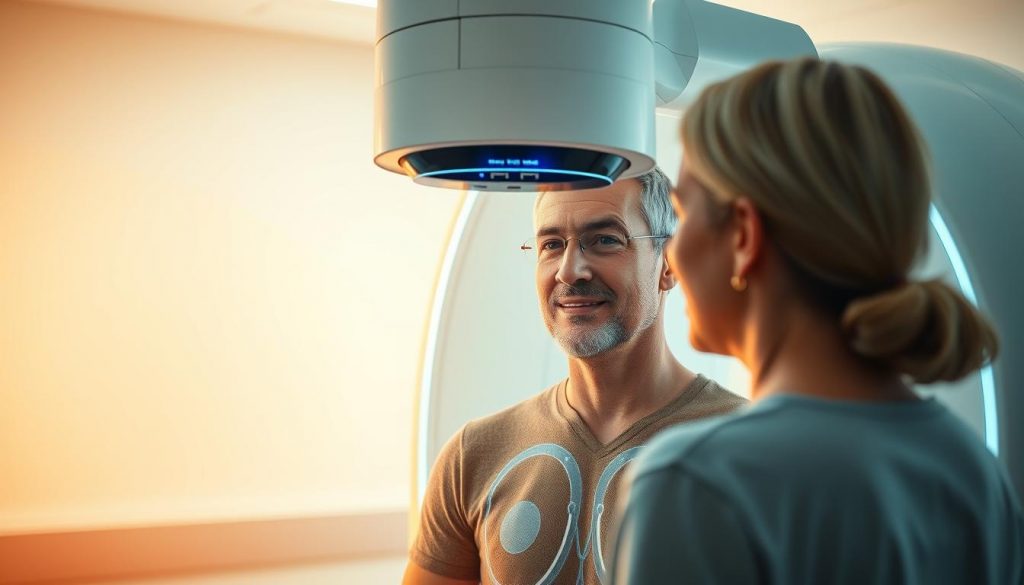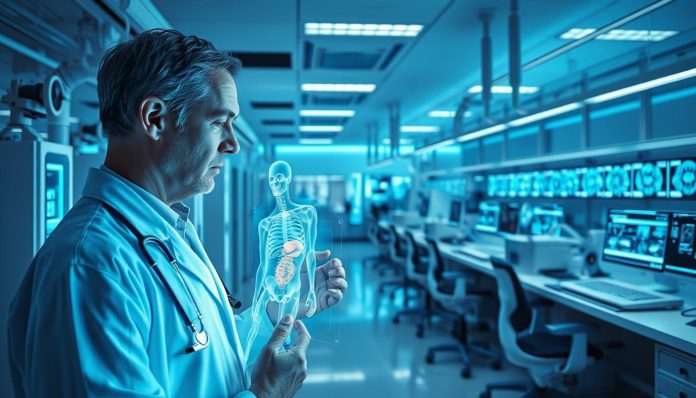Over half of NHS trusts used AI across imaging workflows in 2023, a leap that has reshaped how hospitals prioritise and report scans for various diseases.
The promise is clear: faster triage, scaled interpretation, and potential gains for patient care based on accurate diagnoses. Yet evidence from 140 studies (2020–2025) is mixed and often drawn from simulated settings, not live wards, leaving researchers questioning the reliability of this healthcare technology.
This section frames the central question: whether the latest healthcare technology delivers consistent, expert-level results in real clinical practice. It points to where research shows benefits and where gaps remain in the information available to doctors and patients.
The balanced verdict suggested here is pragmatic. The most credible path appears to be a human–machine partnership that boosts outcomes while preserving clinical oversight, providing better ways to manage health. For wider context on radiology adoption and modernisation, see a review of NHS progress and sector trends alongside national analysis.
Readers will find clear findings on performance, workflow effects and the research needed to move from promise to dependable practice. For background evidence across device approvals and global workforce pressures, explore a detailed study review of published research.
Key Takeaways
- Adoption is rising quickly across NHS imaging, but real-world evidence is still limited.
- Studies show promising diagnostic gains, yet many are simulation-based.
- Reliable use depends on data quality, clinical context and governance.
- Near-term success is most likely via pragmatic human–machine partnerships.
- Health leaders should align adoption to clear clinical problems and measurable outcomes.
Latest healthcare technology meets the clinic: what the UK and global evidence really shows
Clinical practice is where the latest healthcare technology faces its toughest tests and reveals true limits.
NHS radiology adoption is rapid: 54% of trusts reported using tools by 2023 to help with image interpretation, prioritisation or reporting. A scoping review of 140 studies (2020–2025) looked at diagnostic accuracy, workflow, cost and user experience. This research highlights the importance of data in enhancing the ability of doctors to make accurate diagnoses.
Study results are mixed. Of 25 studies measuring diagnostic accuracy, 19 showed improvement. Of 18 studies on reading time, 13 found faster reporting with assistive support, showcasing the potential of artificial intelligence in healthcare. Yet several analyses noted higher false positives.
Most evaluations happened in simulated settings, not live wards. That leaves questions about performance at the scanner-to-report level and downstream patient pathways. Implementation varied widely, with limited guidance and notable resource demands for overstretched systems. Researchers emphasize the need for better content and language in reporting these findings.
Findings justify cautious optimism, but better data from routine practice are needed to confirm consistent diagnostic accuracy and real-world results in terms of health outcomes and patient experience.
NHS radiology’s rapid adoption and what’s still unknown
| Metric | Number of studies | Positive findings | Limitations |
|---|---|---|---|
| Diagnostic accuracy | 25 | 19 improved | Mostly controlled environments |
| Reading time | 18 | 13 faster | Variable across image types |
| Implementation | 140 (scoping) | Several pilots | Insufficient guidance; resource costs |
- Evidence supports gains in accuracy and time, but results vary by disease area and images type.
- Researchers warn that simulated studies may not reflect routine practice or diverse populations.
- Health leaders need better data, governance and resource planning to turn promising results into reliable practice.
The Promise: Where AI Excels in medical diagnostics
Real-world trials point to concrete strengths: faster sorting of routine work and earlier detection of treatable conditions.

Early and rapid disease detection across imaging workflows
Pattern recognition across images helps surface subtle signs of disease that might delay an accurate diagnosis. When used alongside clinicians, models have shortened reporting time and raised diagnostic accuracy in many pilots.
Democratising healthcare: triage, access and relieving workforce pressures
Screening programmes show promise. Independent triage has excluded many normal chest X‑rays and mammography support found about 20% more cancers while cutting radiologist workload by nearly half.
That shift can free experts to focus on complex cases, improve patient access and ease pressure on stretched systems.
A glimpse into success: efficiency gains and potential accuracy improvements
Studies report quicker callbacks and faster treatment starts where specificity stayed acceptable. Used as a tool inside defined systems, the technology directs scarce expertise to higher‑risk work and can improve patient outcomes.
| Use case | Reported gain | Clinical note |
|---|---|---|
| Chest X‑ray triage | High exclusion of normals | Speeds pathway; needs oversight for rare findings |
| Mammography support | ~20% more cancers; ~50% workload reduction | Best when paired with double reading or clinical review |
| Reading time reduction | Faster reporting | Quicker callbacks; dependent on specificity |
When targeted to specific bottlenecks, the approach can scale benefits while preserving clinician judgment and patient safety.
- Ability to detect subtle patterns boosts accurate diagnoses with oversight.
- Time savings translate to quicker care when systems manage false positives.
- Models work best as tools within clear workflows, not as blanket replacements.
The Reality: The Challenges and Risks in real-world use
Real-world rollout exposes gaps that lab tests often miss. Practical use in busy trusts has revealed limits that affect patient care and staff workload.

Data bias and lack of generalisation are common problems. Many models show strong results in controlled studies but perform unevenly across different scanners, hospitals and populations.
The black box problem undermines trust. Limited explainability makes it hard for physicians and doctors to justify decisions or to explain results to patients.
Accountability is unsettled. Clinicians, vendors and trusts must define the role each plays when errors occur. Training and clear information for patients are essential to maintain confidence.
Early sensitivity gains can come with more false positives, extra tests and pathway congestion unless systems include monitoring and recalibration.
Implementation gaps and regulatory strain
Evidence shows inconsistent deployment and scarce resources for scale-up. The overstretched NHS faces procurement, validation and assurance challenges that slow safe adoption.
| Risk | Impact on practice | Mitigation |
|---|---|---|
| Data bias | Uneven results across sites | Bias monitoring and diverse training data |
| Explainability limits | Reduced clinician trust | Transparent reporting and user training |
| Liability uncertainty | Delayed adoption; legal risk | Clear governance, contracts and audit |
| Resource gaps | Implementation delays | Protected training time and funded pilots |
- Patients need clear consent and plain information about use and likely outcomes.
- A pragmatic approach links adoption to defined problems, measurable goals and continuous review.
Is AI in Medical Diagnostics Truly Reliable? Find Out Now!
Published studies and recent technology news show a mixed picture for current performance in healthcare. Some task-specific wins exist, but overall reliability has not yet matched expert clinicians across routine practice in diagnoses.
The verdict: not yet matching expert-level reliability. A randomised trial across three US hospitals found clinician teams using ChatGPT Plus scored about 76.3% accuracy versus 73.7% with conventional resources. The same system, working alone on structured scans and vignettes, reached a median accuracy above 92% over the years.
Not yet matching expert-level reliability in practice: mixed study results and false positives
Imaging studies show targeted approaches can help. Mammography support lifted cancer detection by ~20% and halved radiologist workload. Triage tools have safely excluded many normal chest X‑rays to focus expert review.
ai technology news and artificial intelligence news: when AI alone outperforms human-AI teams
Some research reports show models perform better alone on structured cases. That suggests gaps in workflow design, prompt standards and clinician training.
“Reliability depends on aligning models to well-defined tasks, defining clinician roles and measuring outcomes,” say several researchers and an author collective.
- Doctors and physicians can discount algorithmic information, reducing gains.
- To improve diagnosis accuracy and patient care, invest in governance, prompt standards and team training.
- Toward a balanced, human‑AI diagnostic partnership: let models handle routine cases while clinicians manage complex decisions.
Conclusion: Is AI in Medical Diagnostics Truly Reliable? Find Out Now!
A balanced judgement recognises targeted wins, real-world gaps and a road to safer adoption.
The promise is clear: targeted tools can speed work, support earlier treatment and raise diagnostic accuracy in screening and triage. The reality is mixed results across broader tasks and limited patient‑reported data from routine practice.
The verdict: a human–intelligence partnership for the future. Reliable use will come when organisations pair tools with governance, funded resources, structured training for physicians and clear role definitions for staff.
Programmes should set problem‑driven goals, monitor data for bias, report outcomes and explain use to patients. With rigorous study, transparent reporting and careful integration, teams can harness potential to improve patient care and patient outcomes while limiting harm.
For more articles on Healthcare and Technology, please follow the link.


